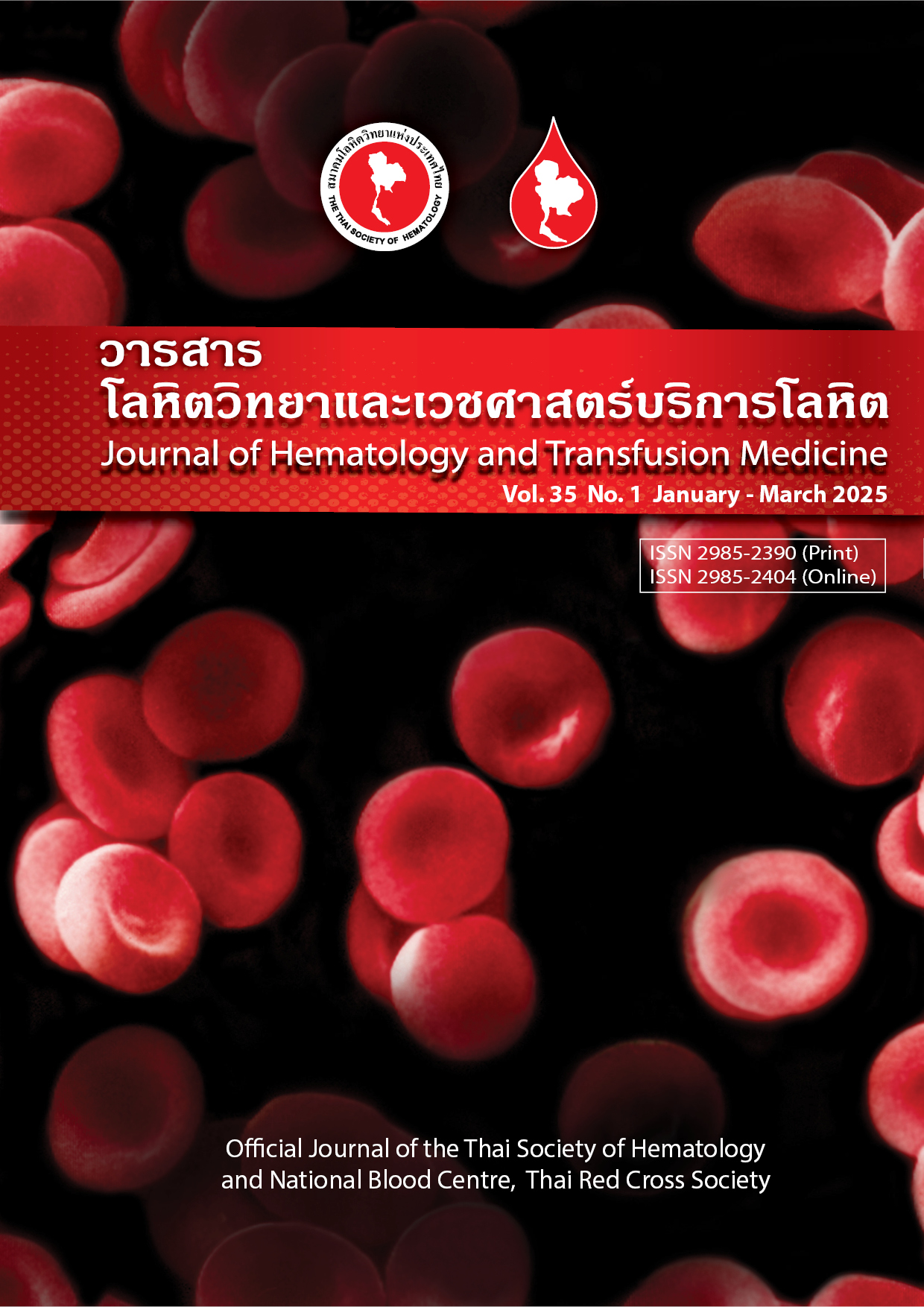Prognostic factors and outcomes of pediatric acute lymphoblastic leukemia using ThaiPOG protocols: a single institute experience
DOI:
https://doi.org/10.69898/jhtm.35.2025.274105Keywords:
Pediatric acute lymphoblastic leukemia, cytogenetics, infection, SurvivalAbstract
Background Acute lymphoblastic leukemia (ALL) is the most common malignancy among children. Disease-based risk stratification was incoporated in the Thai Pediatric Oncology Group (ThaiPOG) protocols to adjust intensive chemotherapies,and central nervous system-directed treatment. Although treatment outcomes have improved over the decade, excellent outcomes are counterbalanced by treatment-related toxicities, especially in countries with limited resources like Thailand. Objective The single institute study aimed to evaluate prognostic factors associated with survival outcomes in pediatric ALL using ThaiPOG protocols at Phramongkutklao Hospital. Materials and methods Pediatric patients with ALL treated at Phramongkutklao Hospital between 2014 and 2019 were retrospectively reviewed. Results In total, 50 patients with a median age of 9.64 (range, 0.34-19.81) years were studied. The most common immunophenotype was pre-B cell ALL (N = 42, 84%). The 5-year overall survival (OS) and event-free survival (EFS) were 80% and 76%, respectively. The major mortality cause was treatment-related infection (N = 7, 14%). Unfavorable cytogenetics was the only factor associated with OS (p = 0.006) and EFS (p < 0.001). Conclusion The outcomes of pediatric ALL in Thailand were comparable to those of developed countries. Cytogenetic testing is essential for stratifying disease status and tailoring treatment protocol accordingly. Infections remain the leading cause of death among pediatric patients with ALL.
Downloads
References
Steliarova-Foucher E, Colombet M, Ries LAG, Moreno F, Dolya A, Bray F, et al. International incidence of childhood cancer, 2001-10: a population-based registry study. Lancet Oncol. 2017;18:719-31.
World Health Organization. (2021). CureAll framework: WHO global initiative for childhood cancer: increasing access, advancing quality, saving lives. World Health Organization. https://www.who.int/publications/i/item/9789240025271.
Wiangnon S, Kamsa-Ard S, Jetsrisuparb A, Sriplung H, Sontipong S, Sumitsawan Y, et al. Childhood cancer in Thailand: 1995-1997. Asian Pac J Cancer Prev. 2003;4:337-43.
Wiangnon S, Veerakul G, Nuchprayoon I, Seksarn P, Hongeng S, Krutvecho T, et al. Childhood cancer incidence and survival 2003-2005, Thailand: study from the Thai Pediatric Oncology Group. Asian Pac J Cancer Prev. 2011;12:2215-20.
Pui CH, Campana D, Pei D, Bowman WP, Sandlund JT, Kaste SC, et al. Treating childhood acute lymphoblastic leukemia without cranial irradiation. N Engl J Med. 2009;360:2730-41.
Schultz KR, Pullen DJ, Sather HN, Shuster JJ, Devidas M, Borowitz MJ, et al. Risk- and response-based classification of childhood B-precursor acute lymphoblastic leukemia: a combined analysis of prognostic markers from the Pediatric Oncology Group (POG) and Children's Cancer Group (CCG). Blood. 2007;109:926-35.
Gatta G, Rossi S, Foschi R, Trama A, Marcos-Gragera R, Pastore G, et al. Survival and cure trends for European children, adolescents and young adults diagnosed with acute lymphoblastic leukemia from 1982 to 2002. Haematologica. 2013;98:744-52.
Choudhry VP, Krishnamurthy L, Arya LS, Desai N, Pati H. Causes of mortality in children with acute lymphocytic leukemia. Indian Pediatr. 1992;29:709-13.
Rujkijyanont P, Kaewinsang S, Monsereenusorn C, Traivaree C. Pediatric Acute Leukemia: The Effect of Prognostic Factors on Clinical Outcomes at Phramongkutklao Hospital, Bangkok, Thailand. J Med Assoc Thai. 2014;97(Suppl. 2):S188-S195.
Schulga P, Grattan R, Napier C, Babiker MO. How to use… lumbar puncture in children. Arch Dis Child Educ Pract Ed. 2015;100:264-71.
Kruse A, Abdel-Azim N, Kim HN, Ruan Y, Phan V, Ogana H, et al. Minimal Residual Disease Detection in Acute Lymphoblastic Leukemia. Int J Mol Sci. 2020;21:1054.
Monsereenusorn C, Sricharoen T, Rujkijyanont P, Suwanpakdee D, Photia A, Lertvivatpong N, et al. Clinical Characteristics and Predictive Factors of Invasive Fungal Disease in Pediatric Oncology Patients with Febrile Neutropenia in a Country with Limited Resources. Pediatric Health Med Ther. 2021;12:335-45.
Crist WM, Pui CH. Clinical implications of cytogenetic and molecular analyses of pediatric acute lymphoblastic leukemia. Stem Cells. 1993;11:81-7.
Chennamaneni R, Gundeti S, Konatam ML, Bala S, Kumar A, Srinivas L. Impact of cytogenetics on outcomes in pediatric acute lymphoblastic leukemia. South Asian J Cancer. 2018;7:263-6.
Schultz KR, Bowman WP, Aledo A, Slayton WB, Sather H, Devidas M, et al. Improved early event-free survival with imatinib in Philadelphia chromosome-positive acute lymphoblastic leukemia: a children's oncology group study. J Clin Oncol. 2009;27:5175-81.
Jeha S, Pei D, Raimondi SC, Onciu M, Campana D, Cheng C, et al. Increased risk for CNS relapse in pre-B cell leukemia with the t(1;19)/TCF3-PBX1. Leukemia. 2009;23:1406-9.
Health Quality Ontario. Minimal Residual Disease Evaluation in Childhood Acute Lymphoblastic Leukemia: A Clinical Evidence Review. Ont Health Technol Assess Ser. 2016;16:1-52.
Möricke A, Reiter A, Zimmermann M, Gadner H, Stanulla M, Dördelmann M, et al. Risk-adjusted therapy of acute lymphoblastic leukemia can decrease treatment burden and improve survival: treatment results of 2169 unselected pediatric and adolescent patients enrolled in the trial ALL-BFM 95. Blood. 2008;111(9):4477-89.
Borowitz MJ, Devidas M, Hunger SP, Bowman WP, Carroll AJ, Carroll WL, et al. Clinical significance of minimal residual disease in childhood acute lymphoblastic leukemia and its relationship to other prognostic factors: a Children's Oncology Group study. Blood. 2008;111(12):5477-85.
Downloads
Published
Issue
Section
License
Copyright (c) 2025 Journal of Hematology and Transfusion Medicine

This work is licensed under a Creative Commons Attribution-NonCommercial-NoDerivatives 4.0 International License.


